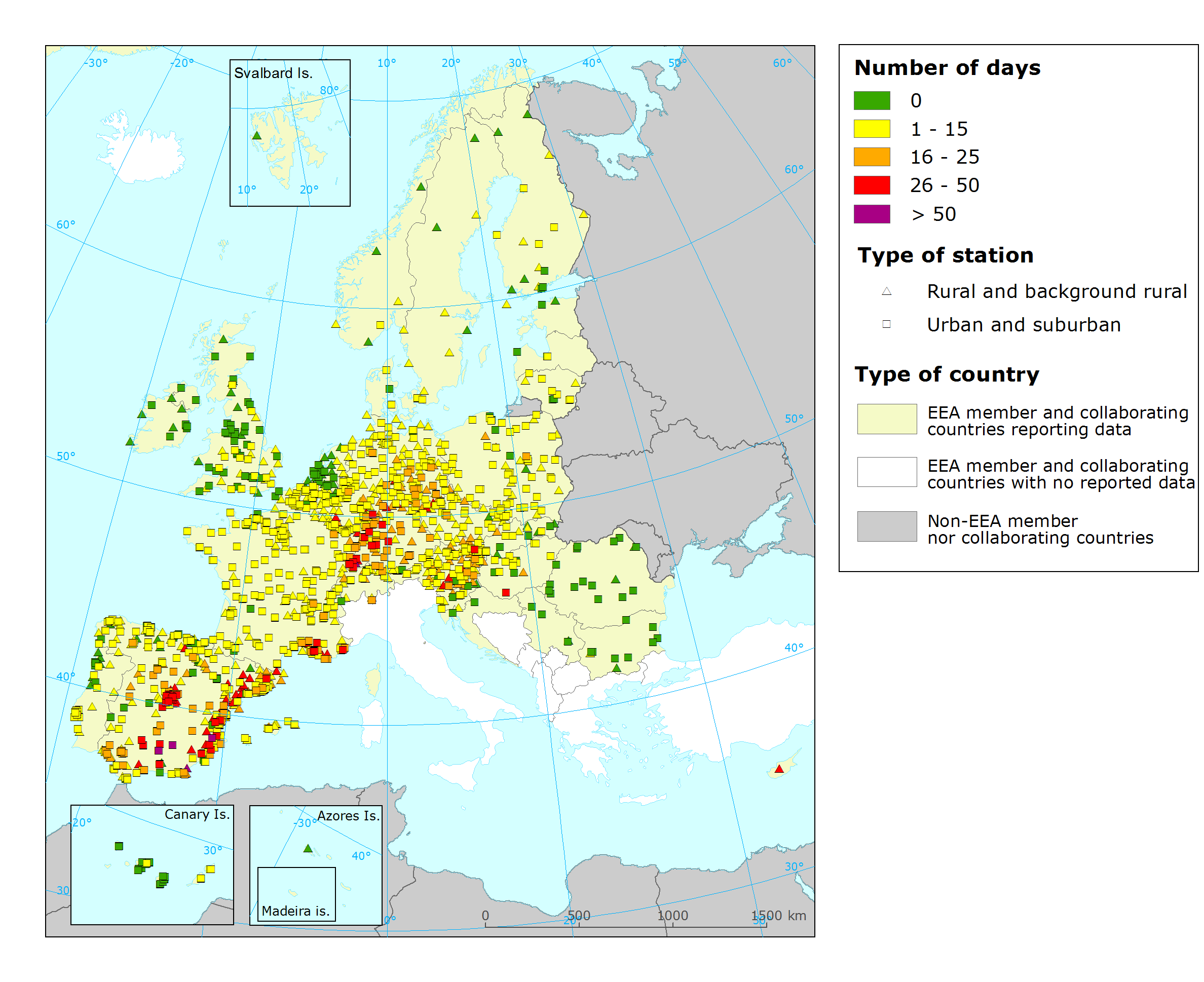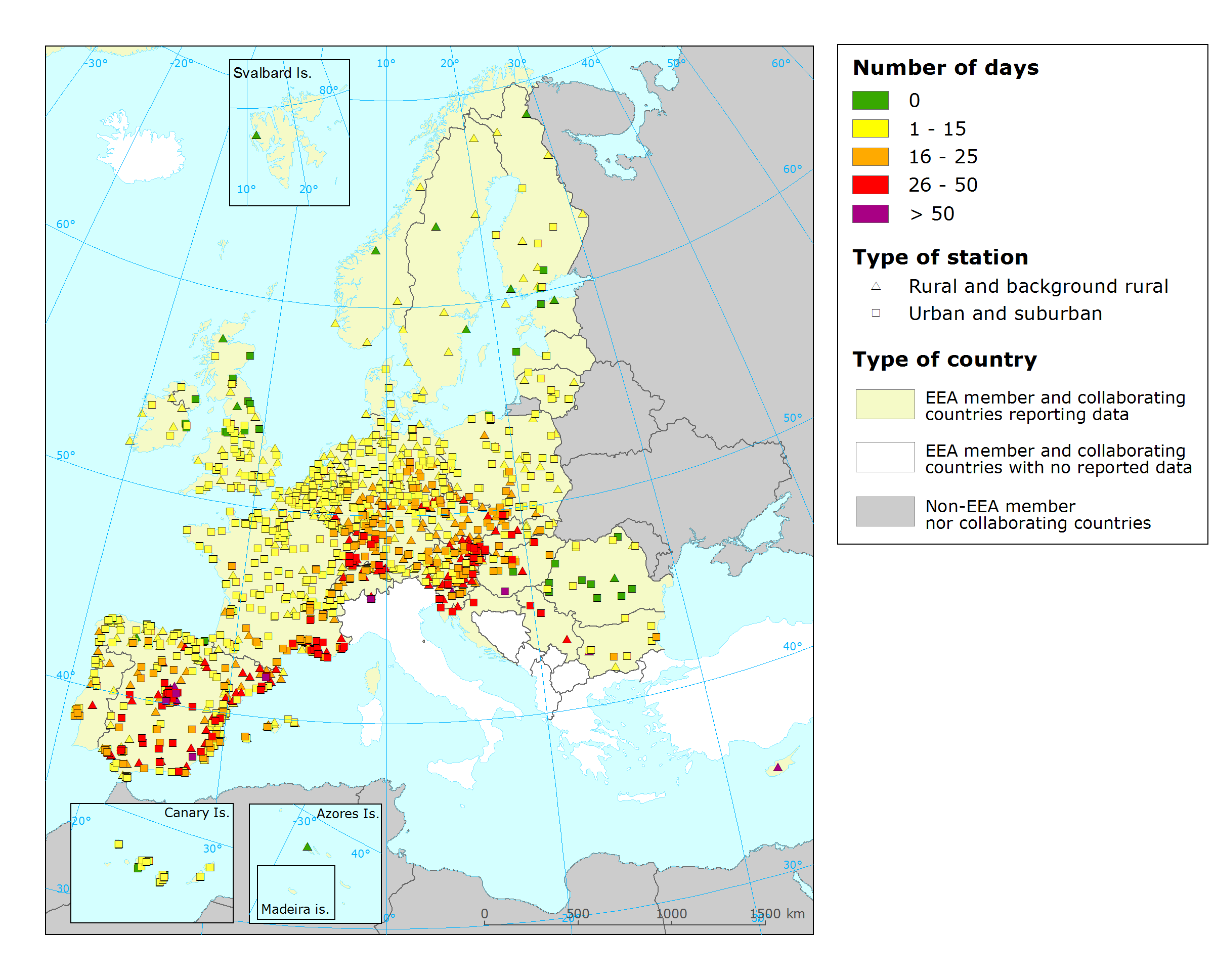Exceedance of the long-term objective (LTO) for the protection of human health
- LTO was exceeded in all reporting countries except Croatia, Estonia, Ireland, Romania and Serbia.
- Approximately 81% of all the reporting stations recorded at least one exceedance during the summer period.
- The maximum number of exceedance days per country was 150 (out of a maximum of 183 days) in Spain.
- On average, those stations observing at least one LTO exceedance reported a total of 11 days of exceedance. The maximum number of 63 exceedance days was observed at the station Villanueva del Arzobispo in Spain.
- The highest number of exceedances occurred during June and July (35% of all observed exceedances in each month)
|
Country
|
Number
of
stations
|
Number of stations
with TV exceedances
|
Percentage of stations
with TV exceedances
|
Maximum number of
days on which the TV
was exceeded
|
|
Austria
|
105
|
38
|
36.2
|
50
|
|
Belgium
|
39
|
0
|
0.0
|
15
|
|
Bulgaria
|
17
|
1
|
5.9
|
63
|
|
Croatia
|
2
|
2
|
100.0
|
26
|
|
Cyprus
|
1
|
1
|
100.0
|
65
|
|
Czech Republic
|
51
|
3
|
5.9
|
42
|
|
Denmark
|
6
|
0
|
0.0
|
4
|
|
Estonia
|
2
|
0
|
0.0
|
0
|
|
Finland
|
18
|
0
|
0.0
|
4
|
|
France
|
298
|
23
|
7.7
|
65
|
|
Germany
|
250
|
18
|
7.2
|
41
|
|
Greece
|
0
|
-
|
-
|
-
|
|
Hungary
|
17
|
4
|
23.5
|
64
|
|
Ireland
|
10
|
0
|
0.0
|
1
|
|
Italy
|
0
|
-
|
-
|
-
|
|
Latvia
|
3
|
0
|
0.0
|
0
|
|
Lithuania
|
13
|
0
|
0.0
|
8
|
|
Luxembourg
|
5
|
1
|
20.0
|
32
|
|
Malta
|
0
|
-
|
-
|
-
|
|
Netherlands
|
33
|
0
|
0.0
|
9
|
|
Poland
|
62
|
1
|
1.6
|
26
|
|
Portugal
|
37
|
1
|
2.7
|
28
|
|
Romania
|
17
|
0
|
0.0
|
6
|
|
Slovakia
|
15
|
3
|
20.0
|
41
|
|
Slovenia
|
11
|
5
|
45.5
|
73
|
|
Spain
|
357
|
68
|
19.0
|
65
|
|
Sweden
|
9
|
0
|
0.0
|
5
|
|
United Kingdom
|
74
|
0
|
0.0
|
7
|
|
EU area
|
1452
|
169
|
11.6
|
|
|
Norway
|
7
|
0
|
0.0
|
1
|
|
Serbia
|
3
|
3
|
100.0
|
39
|
|
Switzerland
|
29
|
7
|
24.1
|
56
|
|
Whole area
|
1491
|
179
|
12.0
|
|
Note: Bold numbers refer to countries with exceedances of the 2012 TV
Source: EEA - Airbase and Air quality e-reporting database
Exceedance of the target value (TV) for the protection of human health
- During summer 2014, more than 25 LTO exceedances occurred at stations in 7 EU Member States (Austria, Cyprus, France, Germany, Hungary, Luxembourg, and Spain).
- More than 25 LTO exceedances occurred at 6% of all reporting stations. This corresponded to approximately 1.1% of the area assessed, affecting approximately 1.0% of the total population.
- The 2012 TV (averaged for 2012-2014) could be calculated for all Member States (except Greece, Italy and Malta) and 3 other countries (Norway, Serbia and Switzerland). Only stations for which the number of LTO exceedances was available for all three summers of 2012–2014 were considered. This calculation is made only for information purposes.
- From a total of 2 280 stations reporting data from at least one year in 2012, 2013 and 2014, only 1 491 (65%) could be used for the 2012 TV calculation. Of these, 179 stations (12%) had exceedances of the TV.
- The 2012 TV was exceeded in 14 reporting EU Member States (Austria, Bulgaria, Croatia, Cyprus, the Czech Republic, France, Germany, Hungary, Luxembourg, Poland, Portugal, Slovakia, Slovenia and Spain) and in two of the other reporting countries with enough data in the three years period (Serbia and Switzerland).
Main ozone episodes
An 'ozone episode' is defined as 'a period of usually a few days up to two to three weeks with high ozone concentrations, characterised by daily exceedances of the thresholds set to protect human health. Ozone episodes occur under specific meteorological conditions characterised by large stagnant areas of high pressure. Since the formation of ozone requires sunlight, ozone episodes mainly occur during summer.
Summer 2014 was characterised by very few exceedances with only several days with increased concentrations. One of these episodes occurred between 7 and 14 June, during which approximately 36% of the total number of exceedances of the information threshold, 75% of exceedances of the alert threshold, and 20% of LTO exceedances experienced during the summer took place.
About this assessment
Ozone (O3) is a 'secondary' pollutant formed from gases such as nitrogen oxides (NOX) and volatile organic compounds (VOCs) in the presence of solar light. Ozone levels typically become particularly high in regions where considerable emissions of these gases combine with stagnant meteorological conditions, high levels of solar radiation and high temperatures during the summer. Summer refers to the period from April to September.
Exposure to high O3 concentrations can cause breathing problems, trigger asthma, reduce lung function and cause lung diseases.
Ozone is regulated under the Air Quality Directive (EU, 2008), which set some thresholds for ozone concentrations:
- information threshold: 1-hour average ozone concentration of 180 μg/m3,
- alert threshold: 1-hour average ozone concentration of 240 μg/m3,
- long term objective (LTO): the maximum daily 8-hour mean concentration of ozone should not exceed 120 μg/m3,
- target value (TV): LTO should not be exceeded on more than 25 days per calendar year, averaged over 3 years.
For description purposes a target value threshold (TVt) is also considered: LTO should not be exceeded on more than 25 days in a calendar year (instead of over the 3 year average).
Until 2014, Member States had to officially report on the summer ozone exceedances of these thresholds. Based on this past reporting, the European Environment Agency (EEA) has published annual Technical Reports analysing the summer ozone situation across Europe. After the entry into force of new EU rules for reporting air quality information (EU, 2011) a new system for reporting data was established. For the first time the analysis of the summer 2014 period was based on this new system. In total, 1 607 ozone-monitoring sites reported data; of these, 1 562 were located in EU Member States.



Document Actions
Share with others